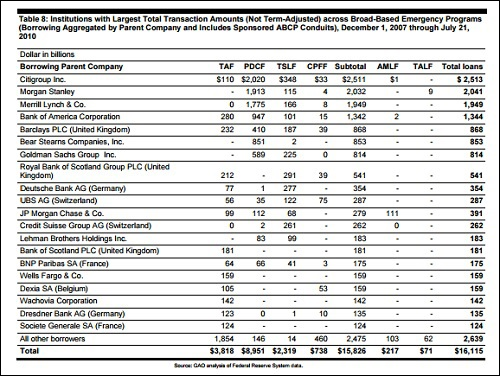By Pam Martens and Russ Martens: November 18, 2019 ~

James Gorman (left) Chairman and CEO, Morgan Stanley; David Solomon (right) Chairman and CEO, Goldman Sachs
Last week, Jim Grant, the Editor of Grant’s Interest Rate Observer, was interviewed by CNBC’s Rick Santelli. Grant said that since September 17, the Fed has pumped “upwards of $3 trillion” in repo loans to Wall Street. Santelli asked if the Fed had effectively nationalized the repo market. Grant said “there is no more price discovery and we are dealing with administered rates.”
For the first time since the financial crisis, the Federal Reserve Bank of New York has been pumping out hundreds of billions of dollars each week to trading houses on Wall Street in order to provide liquidity to the repo (repurchase agreement) market where financial institutions make collateralized, overnight loans to each other. Liquidity had dried up in this market to the point that on September 17 overnight lending rates spiked from the typical 2 percent to 10 percent. The Fed then turned on its money spigot and brought the rate back down. But even after the rate went back down, the New York Fed has continued making these massive loans, raising fears on Wall Street about what is really going on behind the scenes.
Thus far, Fed Chairman Jerome Powell has tried to peddle the narrative that the Fed is just making “technical” adjustments through its open market operations rather than launching another massive bailout program to Wall Street. Congress has failed to conduct one hearing on the serious matter, even as the program has grown. Just last Thursday the Fed announced that in addition to its daily offering of $120 billion in overnight loans and twice-weekly offering of $35 billion in 14-day loans, it will be adding three more term loans over the next month, totaling $55 billion in 28-day and 42-day term loans.
There is some evidence residing quietly on the Federal Reserve’s web site that it has been planning for the next Wall Street crisis since at least August 11, 2011. That’s when Morgan Stanley Bank NA shows up as a borrower at the Discount Window of the New York Fed, receiving a $1 million overnight loan at the rate of 0.75 percent against pledged collateral of $13.6 billion. These practice runs by Morgan Stanley at the New York Fed’s Discount Window have continued since that time. The Fed makes its Discount Window disclosures on a two-year lag time. According to its most recent data for the third quarter of 2017, Morgan Stanley Bank NA received a $500,000 overnight loan from the Discount Window on September 13, 2017 at an interest rate of 1.75 percent against pledged collateral of $10.7 billion.
Morgan Stanley Bank NA is the federally-insured bank of Morgan Stanley, a sprawling Wall Street investment bank that received more than $2 trillion in secret revolving loans from the Fed during the last financial crisis. (See chart from federal agency audit below.) On September 29, 2008, the day that the House of Representatives initially rejected the proposed TARP taxpayer bailout plan (which would eventually, and publicly, inject $10 billion into Morgan Stanley) it secretly received $61.28 billion from the Fed’s Primary Dealer Credit Facility.
Goldman Sachs has also been conducting these periodic test runs with the New York Fed’s Discount Window since October 15, 2013, when it borrowed $100,000 at 0.75 percent against collateral of $325,000. Most notable about the situation with Goldman Sachs is that its practice runs have continued at the level of $100,000 through the third quarter of 2017, but on September 20, 2017 when it borrowed its typical $100,000, it was against pledged collateral of $12.37 billion. According to the Office of the Comptroller of the Currency, when taking Goldman Sachs’ derivatives into consideration, its total credit exposure to capital stands at 372 percent.
Both Morgan Stanley and Goldman Sachs were investment banks with no access to the Fed’s Discount Window until September 2008. Both requested and received permission to become bank holding companies, entitling them to borrow at the Fed’s Discount Window, the weekend after Lehman Brothers filed for bankruptcy on September 16, 2008.
According to our sources, the Federal Reserve is either requiring or requesting that any bank that may have the need to make daylight overdrafts of its reserves at the Federal Reserve regional banks, or might have a need to borrow from the Discount Window, maintain a formulaic amount of pledged collateral at the Federal Reserve bank of which it is a member.
The largest and most dangerous banks in the country are members of the New York Fed. But for reasons that remain thus far unexplained, among the mega banks on Wall Street, we find only the names of Morgan Stanley and Goldman Sachs on the Discount Window list of test run borrowers since 2011. JPMorgan Chase, a three-count felon whose precious metals trading desk is currently under an ongoing criminal probe for racketeering (with multiple indictments already handed down) does not show up as conducting any practice runs. Nor does Citigroup, the largest recipient of the New York Fed’s bailout loans during the financial crisis when it received over $2.5 trillion in secret revolving loans from the Discount Window, the Primary Dealer Credit Facility and other Fed programs from 2007 to at least the middle of 2010. (See chart below.)
We do know, however, that JPMorgan Chase has standing, pledged collateral at the Fed because it makes reference to it in its most recent 10-Q filing with the Securities and Exchange Commission. The JPMorgan Chase statement reads:
“As of September 30, 2019, the Firm also had approximately $313 billion of available borrowing capacity at FHLBs [Federal Home Loan Banks], the discount window at the Federal Reserve Bank, and other central banks as a result of collateral pledged by the Firm to such banks. This borrowing capacity excludes the benefit of securities reported in the Firm’s HQLA [High-Quality Liquid Assets] or other unencumbered securities that are currently pledged at the Federal Reserve Bank discount window. Although available, the Firm does not view this borrowing capacity at the Federal Reserve Bank discount window and the other central banks as a primary source of liquidity.”
The reason that JPMorgan Chase and other Wall Street mega banks do not want to say that they view the Discount Window as a key source of borrowing is that there is an age-old stigma attached to borrowing at that window. It is assumed that if you need to borrow from the Fed, known as the “lender-of-last-resort,” it’s because you are in such dire straits that other financial institutions will not lend to you.
The Federal Reserve waged a multi-year court battle during the financial crisis in an effort to avoid naming the bank recipients of its massive bailout programs, which included the Discount Window. After losing its case at the District Court and Second Circuit Appellate Court, a consortium of Wall Street banks called the Clearing House (which includes JPMorgan Chase and Citigroup) took the case to the U.S. Supreme Court, which refused to hear the case.
That forced the Fed to release the details of its massive Discount Window loans on March 31, 2011 – almost three years after Bloomberg News reporter Mark Pittman had first filed a Freedom of Information Act request for the data and was stonewalled. (Pittman died before the data was released.)
The data showed that the same banks that were being supervised by the New York Fed were the largest recipients of the Fed’s obscene amounts of secret loans. Despite its clear ineptitude at supervising these behemoths, it remains their supervisor even after the Dodd-Frank financial reform legislation was passed by Congress in 2010.
One New York Fed program, the Primary Dealer Credit Facility (PDCF), doled out $8.95 trillion in revolving loans against dodgy collateral like stocks and junk bonds – at a time when both were in freefall. Citigroup received $2.02 trillion from that program. Morgan Stanley was the second largest borrower in that program, receiving $1.9 trillion. Merrill Lynch received $1.8 trillion. (See GAO audit chart below.)
Today, the New York Fed seems to be back at the game of electronically creating trillions of dollars out of thin air and doling it out to Wall Street banks that are proving all over again that they are too big to supervise, too derelict to govern themselves and need to be broken up for the good of the country.


